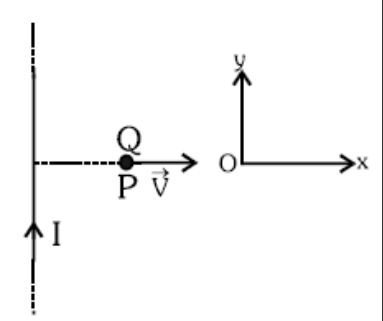Two very long straight parallel wires carry steady currents I and -I. The distance between the wires is d. At a certain instant of time, a point charge 'q' is at a point equidistant from the two wires, in the plane of the wires. Its instantaneous velocity 'v' is perpendicular to this plane. The magnitude of the force due to the magnetic field acting oh the charge at this instant isSolution in Telugu
μ0Iqv2πd
μ0Iqvπd
2μ0Iqvπd
zero
The correct Answer is:D
Step by step video, text & image solution for Two very long straight parallel wires carry steady currents I and -I. The distance between the wires is d. At a certain instant of time, a point charge 'q' is at a point equidistant from the two wires, in the plane of the wires. Its instantaneous velocity 'v' is perpendicular to this plane. The magnitude of the force due to the magnetic field acting oh the charge at this instant is by Physics experts to help you in doubts & scoring excellent marks in Class 12 exams.
Updated on:21/07/2023Topper's Solved these Questions
- MOVING CHARGES AND MAGNETISMBook:AAKASH SERIESChapter:MOVING CHARGES AND MAGNETISMExercise:EXERCISE-IB
Explore 71 Videos
- MOVING CHARGES AND MAGNETISMBook:AAKASH SERIESChapter:MOVING CHARGES AND MAGNETISMExercise:EXERCISE-II
Explore 79 Videos
- MOVING CHARGES AND MAGNETISMBook:AAKASH SERIESChapter:MOVING CHARGES AND MAGNETISMExercise:EXERCISE-III
Explore 45 Videos
- MOTION IN A STRAIGHT LINE Book:AAKASH SERIESChapter:MOTION IN A STRAIGHT LINE Exercise:very Short answer type question
Explore 15 Videos
- NUCLEAR PHYSICSBook:AAKASH SERIESChapter:NUCLEAR PHYSICSExercise:ADDITIONAL PRACTICE PRACTICE SHEET (ADVANCED) Integer Type Questions
Explore 4 Videos
Similar Questions
(A) : Magnetic field interacts with a moving charge and not with a stationary charge.
(R) : Magnetic field will be produced by a moving charge but not by a stationary charge.
View SolutionA proton enters a magnetic field of flux density 1.5 T with a velocity of 20×107ms−1 at an angle of 30° with the field. The force on the proton is [ep=1.6×10−19C]
View SolutionA proton, a deuteron and an a particle having same momentum enter a uniform magnetic field at right angles to the field. Then the ratio of their angular momenta during their motion in the magnetic field is
View SolutionGive two examples of the motion of big objects where the object can be treated as a particle and where it cannot be?
View SolutionIn a sample of rock, the ratio of number of 206Pb to 238U nuclei is found to be 0.5. The age of the rock is (18/n)×109ln(32)ln2 year (Assume that all the Pb nuclides in he rock was produced due to the decay of Uranium nuclides and T1/2(238U)=4.5×109 year). Find n.
View SolutionTwo very long, straight , parallel wires carry steady currents I&−I respectively . The distance between the wires is d. At a certain instant of time, a point charge q is at a point equidistant from the wires , in the plane of the wires. Its instantaneous vel,ocity v is perpendicular to this plane. The magnitude of the force due to the magnetic field acting on the charge at this instant is
View SolutionA very long straight wire carries a current I. At the instant when a charge +Q at point P has velocity vecV , as shown, the force on the charge is
View SolutionTwo very long straight parallel wires carry steady currents i and 2i in opposite directions. The distance between the wires is d . At a certain instant of time a point charge q is at a point equidistant from the two wires in the plane of the wires. Its instantaneous velocity vecv is perpendicular to this plane. The magnitude of the force due to the magnetic field acting on t he charge at this instant is
View SolutionTwo very long, straight, parallel wires carry steady currents I and -I respectively.The distance between the wires is d .At a certain instant of time, a point charge q is at a point equidistant from the two wires,in the plane of wires.Its instantaneous velocity vecv is perpendicular to this plane.The magnitude of the force due to the magnetic field acting on the charge at this instant is:
View SolutionTwo very long straight parallel wires carry steady currents I and -I. The distance between the wires is 'd'. At a certain instant of time, a point charge 'q' is at a point equidistant from the two wires, in the plane of wires. Its instanteous velocity 'v' is bot to plane. The magnitude of force due to magnetic field acting on charge at this instant is:
View SolutionA very long straight wire carries a current I. At the instant when a charge +Q at point P has velocity vecv , as shown, the force on the charge is
View SolutionTwo very long straight parallel wires carry steady currents i and 2i in opposite directions. The distance between the wires is d . At a certain instant of time a point charge q is at a point equidistant from the two wires in the plane of the wires. Its instantaneous velocity vecv is perpendicular to this plane. The magnitude of the force due to the magnetic field acting on t he charge at this instant is
View SolutionA very long straight wire carries a current I. At the instant when a charge +Q at point P has velocity→V, as shown, the force on the charge is-

View SolutionTwo very long, straight , parallel wires carry steady currents I&−I respectively . The distance between the wires is d. At a certain instant of time, a point charge q is at a point equidistant from the wires , in the plane of the wires. Its instantaneous vel,ocity v is perpendicular to this plane. The magnitude of the force due to the magnetic field acting on the charge at this instant is
View SolutionA very long straight wire carries a current I. At the instant when a charge +Q at point P has velocity vecV , as shown, the force on the charge is
View Solution

